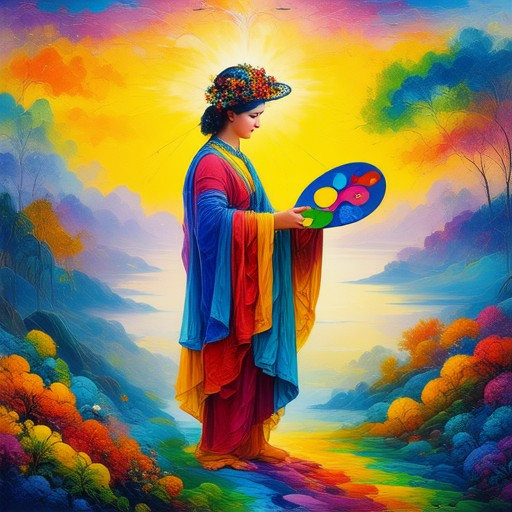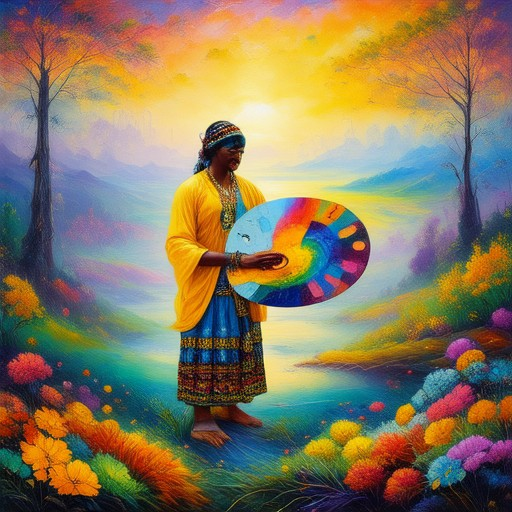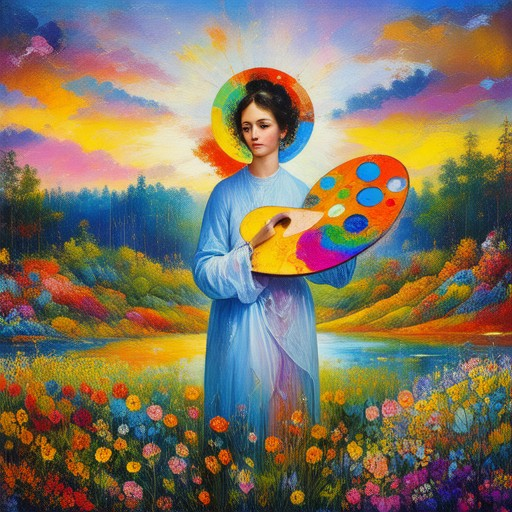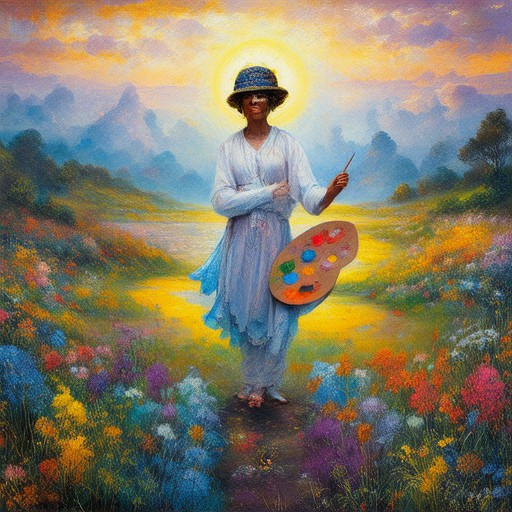Exploring art techniques is a journey that unlocks the door to endless creativity and self-expression. Whether you’re a seasoned artist or just beginning your journey, mastering fundamental techniques can elevate your work to new heights. From traditional mediums to contemporary innovations, this article dives into the essential tools, methods, and approaches that every artist should know. Discover how to explore art techniques for beginners, uncover the seven fundamentals of art, and learn how to develop a unique style that resonates with your vision. By delving into visual art techniques and contemporary practices, this guide offers a comprehensive roadmap for artists of all levels. Additionally, we’ll examine how a global thematic approach can inspire your creations, allowing you to connect with diverse cultures and artistic movements. Whether you’re looking to refine your skills or spark new ideas, this article is your ultimate resource for exploring art techniques and embracing the boundless possibilities of artistic expression.
Key Takeaways
- Engage with global art movements by visiting world-renowned galleries and museums.
- Utilize online platforms to explore diverse artistic styles and communities.
- Connect with artists and discover emerging talents at art fairs and events.
- Develop your unique style through self-reflection and experimentation.
- Expand your skills by exploring various art forms and seeking inspiration globally.
- Foster creativity and innovation by collaborating with others in artistic projects.
- Enhance your artistic journey by embracing critical thinking and effective communication.

What Are the Techniques of Art?
Art techniques encompass a wide range of methods used by artists to create visual works. These techniques vary widely depending on the medium, style, and personal creativity of the artist. Below are some of the most common art techniques:
- Drawing :
Drawing is one of the fundamental art techniques, involving the creation of images using lines, shapes, and shading. Artists use various tools like pencils, pens, or digital software to bring their ideas to life. - Painting :
Painting involves applying paint to a surface, such as canvas, paper, or wood. Different types of paint, like oil, acrylic, or watercolor, offer unique textures and colors. Artists often use brushes, palette knives, or other tools to achieve their desired effect. - Sculpture :
Sculpture is the creation of three-dimensional objects, typically in stone, metal, or clay. Artists shape and mold these materials to convey their vision, producing statues, figurines, or abstract forms. - Printmaking :
Printmaking involves creating prints using techniques like etching, lithography, or screen printing. Artists design original artwork and transfer it onto paper or other surfaces to produce printed pieces. - Photography :
Photography captures light and shadows to create images on film or digitally. Artists use cameras, lenses, and editing software to compose and enhance photos, turning ordinary moments into extraordinary works of art. - Digital Art :
Digital art uses computers and software to create or manipulate images. Tools like Adobe Photoshop, Canva, or Procreate allow artists to combine traditional techniques with modern technology for creative expression. - Mixed Media :
Mixed media combines different materials and techniques to create unique art pieces. Artists may use paint, collage, sculpture, or other elements to blend textures and styles in one work. - Street Art :
Street art is a form of public art created in urban environments, often using graffiti, murals, or installations. Artists use bold colors and innovative techniques to make their work visible and impactful. - Performance Art :
Performance art involves live performances that combine movement, sound, and sometimes multimedia elements. Artists interact with audiences, creating spontaneous and dynamic experiences. - Calligraphy :
Calligraphy is the art of beautiful handwriting, often used in paintings, signs, or decorative pieces. Artists practice intricate lettering to create elegant and artistic designs.
Each of these techniques allows artists to express themselves uniquely, pushing boundaries and inspiring others. Whether traditional or contemporary, these methods continue to evolve, offering endless possibilities for creativity.
Exploring in Art
Artistic exploration is a dynamic and transformative journey that invites individuals to venture beyond conventional boundaries, embracing creativity and curiosity. This process allows us to discover new perspectives, challenge existing norms, and foster a deeper connection with ourselves and our surroundings.
Exploring in art can take many forms:
- Experimentation: Trying new techniques, mediums, or styles allows artists to push creative limits and uncover unique expressions of their individuality.
- Cultural Immersion: Delving into different cultures, historical periods, or artistic movements broadens one’s understanding and sparks fresh ideas.
- Self-Discovery: Through artistic exploration, individuals often gain insight into their emotions, thoughts, and personal narratives, enabling personal growth and self-awareness.
- Community Connection: Collaborative projects and shared artistic experiences strengthen social bonds and foster collective creativity.
To embark on a successful artistic exploration, consider the following steps:
- Start Small: Begin with simple projects or experiments to build confidence and develop your artistic voice.
- Research and Inspire: Explore various art forms, artists, and movements to find inspiration and discover your preferred style.
- Practice Regularly: Dedication is key to mastering new skills and deepening your understanding of art.
- Seek Feedback: Share your work with peers or join communities to gain constructive criticism and valuable insights.
At Artfull Journey, we celebrate the diversity of artistic expression and provide resources to support your exploration. Whether you’re interested in painting, design, or creative writing, our platform offers tutorials, articles, and inspiration to help you thrive as an artist.
Explore with curiosity, embrace imperfection, and let your art reflect the unique story only you can tell. The journey is as meaningful as the destination.
For more tips and resources, visit our Artistic Exploration section and dive into our comprehensive guides on various art forms.

What Are the 7 Fundamentals of Art?
The fundamentals of art are the essential components that every artist uses to create meaningful and impactful works. Mastery of these elements allows artists to convey emotions, tell stories, and capture the essence of their subject matter. Below, we explore the seven core fundamentals of art:
- Line : Line is the foundation of art, serving as both a structural element and a tool for expression. It can be straight, curved, thick, or thin, and is used to define shape, create movement, and establish a sense of direction.
- Shape : Shape is the result of line, but it also has its own unique qualities. Shapes can be geometric (like squares, circles) or organic (like mountains, waves), and they play a crucial role in framing the composition of a piece.
- Space : Space is the area around and between objects, shapes, or forms. It creates depth, perspective, and a sense of balance in a artwork. Effective use of space can make a piece feel more dynamic or serene.
- Value : Value refers to the light and dark areas in a artwork, often called “shading.” It gives objects a three-dimensional appearance and helps guide the viewer’s eye through the composition.
- Form : Form is the three-dimensional aspect of objects, giving them mass and volume. It can be abstract or realistic, and it plays a key role in conveying the subject matter.
- Texture : Texture describes the surface quality of an object or material. It can be smooth, rough, soft, or hard, and it adds depth and interest to a artwork.
- Color : Color is the element that brings life and emotion to art. It communicates mood, evokes feelings, and creates harmony within a piece. Artists use color theory to achieve desired effects.
Mastering these fundamentals allows artists to communicate effectively and create art that resonates with viewers. By understanding and applying these elements thoughtfully, you can unlock your creativity and produce works that stand out.

How to Explore Art
Exploring art can be approached in numerous ways, each offering unique insights into the world of creativity and expression. Here are several methods to discover and engage with art:
1. Visit Galleries and Museums
Galleries and museums are traditional yet effective ways to explore art. Major institutions often feature works from renowned artists across various movements and cultures. Some popular destinations include the Louvre in Paris, the Museum of Modern Art (MoMA) in New York, and the British Museum in London. Many museums now offer digital tours and apps to enhance your experience.
2. Explore Online Platforms
With the rise of digital tools, there are countless online platforms dedicated to art. Websites like ArtStation , Behance , and DeviantArt showcase a vast array of artistic works, from traditional to contemporary. Virtual art walks and 360-degree tours of famous galleries can also be found online.
3. Attend Art Events
Art fairs, festivals, and gallery openings are excellent opportunities to connect with artists and view exclusive works. Events like the Venice Biennale or the Basel Art Fair draw collectors and enthusiasts worldwide. Many cities host monthly art walks or pop-up exhibitions, making it easier to discover new talent.
4. Read About Artists and Art History
Delving into books, articles, and documentaries about artists can provide deeper insight into their motivations and techniques. Resources like Artful Journey’s art history guides offer comprehensive overviews of different periods and styles.
5. Collect Art
For those interested in building a personal collection, exploring art fairs and auctions can reveal hidden gems. Start with affordable pieces to experiment with different styles before investing in more significant works. Websites like Saatchi Art and Etsy offer accessible options for art enthusiasts.
6. Take Art Classes or Workshops
Workshops and classes led by professional artists can teach you techniques and provide feedback on your work. Platforms like Artful Journey’s tutorial series offer step-by-step guidance for painters, sculptors, and more.
7. Discover Street Art
Street art and murals are a dynamic way to explore public expressions of creativity. Cities like Berlin, Melbourne, and São Paulo are known for their vibrant street art scenes. Apps like StreetArt Cities help you locate and learn about urban art around the world.
8. Engage with Local Communities
Joining local art communities can open doors to networking opportunities and exclusive events. Attend meetups, art collectives, or group exhibitions to connect with fellow enthusiasts. Many cities have thriving art districts with regular happenings.
By combining these methods, you can create a well-rounded journey through the art world, whether you’re an aspiring artist, a casual enthusiast, or a serious collector. Exploring art is a lifelong adventure that rewards curiosity and persistence.
Exploring Your Art Style
To explore your art style, start by examining your existing work to identify patterns and common themes. Gather your sketches and observe the techniques, colors, and subjects you frequently use. This self-reflection will help you understand your unique approach.
Next, experiment with new tools and mediums to challenge your creativity. Try watercolor pencils or attend a workshop to learn advanced techniques. For example, you might discover a new way of blending colors that enhances your work.
Explore different art forms to expand your skills. Visit a local gallery or take a class in sculpture or digital art. Engage with the community by joining an art group or collaborating on projects with other artists. This interaction can provide fresh perspectives and ideas.
Seek inspiration from various sources, such as art museums, nature, and other artists. Document your journey in a sketchbook to track your progress and evolution. Share your work online to connect with a broader audience and receive feedback.
Stay updated on art trends and movements by reading articles and watching award ceremonies. This knowledge will inspire new directions for your style and keep you informed about contemporary developments.
By combining self-reflection, experimentation, and continuous learning, you can thoughtfully explore and evolve your art style.

What Are the Four C’s of Art?
The four C’s of art—Critical Thinking, Communication, Collaboration, and Creativity—are foundational principles that shape the way we approach and engage with artistic expression. These concepts are integral to fostering innovation, personal growth, and meaningful creation in the realm of art.
1. Critical Thinking
Critical Thinking in art involves analyzing and interpreting both the artwork and the world around it. It requires viewers to engage deeply with the subject matter, explore different perspectives, and evaluate the artwork’s meaning and purpose. Artists use critical thinking to challenge conventions, experiment with new ideas, and refine their craft. For instance, Marcel Duchamp’s “Fountain,” a readymade sculpture, challenges traditional notions of art by questioning its medium and purpose.
2. Communication
Effective communication in art allows creators to convey ideas, emotions, and stories to others. This skill encompasses both verbal and non-verbal cues, helping artists share their vision clearly. Communication also involves understanding diverse viewpoints, which is crucial in collaborative settings. For example, a painter might use color and composition to tell a story, while a sculptor might use form and texture to evoke a particular emotion.
3. Collaboration
Collaboration in art occurs when individuals come together to create something greater than the sum of their parts. This teamwork is evident in group projects, public art installations, and educational programs. Collaboration fosters creativity by introducing new perspectives and approaches, leading to innovative outcomes. For instance, a community mural project might bring together artists, students, and volunteers to design and paint a shared piece.
4. Creativity
Creativity is the essence of art, enabling artists to transcend conventional thinking and produce original works. It involves the ability to see possibilities where others see obstacles and to express ideas uniquely. Creativity thrives in environments that encourage experimentation and exploration. A prime example is the development of mixed media art, where artists combine unexpected materials to create new visual languages.
By mastering these four C’s, artists can unlock their potential, connect more deeply with their audiences, and contribute meaningfully to their communities. Artful Journey encourages artists to embrace these principles, offering resources and insights to support creative growth and innovation. Explore our articles and tutorials to discover how to harness the power of Critical Thinking, Communication, Collaboration, and Creativity in your artistic journey.
Explore Tutorials




0 Comments